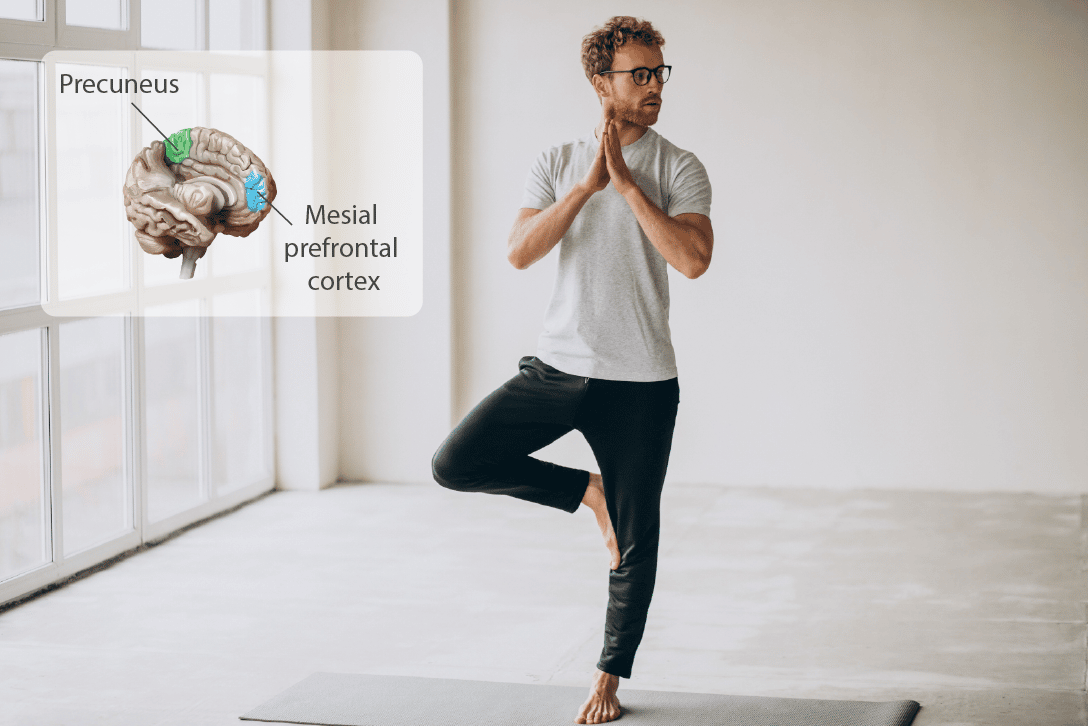What if I told you that meditation can change your brain?
Unless you are a brain researcher or a neuroscience aficionado, chances are that you will open your eyes widely and say “Wow! That’s some powerful stuff!” For a brief moment, your imagination will drive towards Shaolin monks, Jedi knights, and the superpowers that you could obtain if you only get more Zen.
Meditation and mindfulness are the buzzwords of this decade, and the web is vibrant with clickbait articles describing the miracles of brain changes or the panacea for all mental problems.
This is not one of them.
The flexible brain
Table of Contents
The fact that meditation can induce changes in the brain is not special.
Contrary to the hype, it’s not even extraordinary or unexpected. It boils down to the phenomenon of neuroplasticity. The brain is not static: it is a flexible organ that stays in a tight relationship with the external environment, reacting to it and responding to its demands.
Everything you do affects the brain in some way. Similarly, every training affects the brain – after all for you to become more skilled, the change needs to occur somewhere, right?
Meditation is just really good brain training. Spending time staying focused and observing what is really going on in your mind pays off, and it allows the practitioners to have more control over their attention and thoughts also when they’re not meditating.
It is helpful to look at cognitive functions as brain activities that can be practiced in a way similar to developing physical attributes like strength or stamina. It comes naturally to think that we can train brain perks like solving math equations, painting, or programming. But the cognitive processes which underlie our actions are harder to imagine, and because of that, it’s less intuitive to think that they can be trained in a similar way. Can you develop better focus? Yes, you can. Can you train to be less reactive to intense emotions? Sure.

Mind the hype
There are hundreds of thousands of research studies on meditation published throughout the last decade. Does it mean we understand everything about how meditation changes the brain?
No. Getting solid answers is harder than you may think: you can’t just take monks to the lab and scan their brains. You need to train newbies in meditation and see what happens after some time of their practice.
Frankly, the omnipresent hype doesn’t help. The large body of data on meditation is quite chaotic: there are dozens of different meditative training and research protocols. As though there is a lot of enthusiasm for researching meditation, the quality of many studies leaves much to be desired.
We will now go through the key areas of the brain which get changed by meditation, based on the most reliable data.
Body awareness
For most people, it is impossible to feel their own heartbeat without placing a hand on the heart, throat, or wrist. This is likely to change after spending some time training in meditation.
A lot of meditative practices place focus on body awareness at their core. In Vipassana, the key training is based on observing sensations from the body, gradually scanning it while maintaining a perspective of a disengaged observer. Many other meditative traditions also use monitoring body posture, respiration, or tactile feelings as an anchor for the mind. It’s not a surprise that the brain regions which govern your body awareness get a significant boost from body-centered meditation.
The first one is the somatomotor cortex, which serves as a hub for processing sensory information of touch, pain, and all the sensations that you can feel deep within your body.
Another structure where significant changes were observed was the insula. It is linked to the sense of interoception: the awareness of your body’s internal states, including feeling your heartbeat or respiration. Insula is also linked to other aspects of self-awareness: emotional self-awareness, and it may be connected to awareness of thought processes.

Self-awareness: observing thoughts
Meditation was never only about the body. Observing the physical sensations serves to anchor the mind, helping to focus and to be aware of thoughts as they appear. The ultimate skill trained in meditation is self-awareness. Meditators become more aware of the contents of their minds, and this change is reflected in their brains.
Precuneus is a region strongly tied to the two areas we discussed before: the somatomotor cortex and the insula. Together with them, it serves to maintain present-centered awareness, integrating the heightened interceptive attention. It is also linked with self-related processing and shifting attention from object to object.
Another brain area that gets developed by meditators across many different traditions is the prefrontal cortex. I’m sure you’ve heard about it before. It gets a lot of attention because it is the seat of high order and abstract thinking: it processes many thoughts simultaneously at the service of complicated goals.
The parts of the prefrontal cortex developed through meditation are the ones connected with the so-called metacognition. Essentially, metacognition is the mind observing itself: evaluating and judging thoughts that appear, drawing conclusions, and observing thought processes from the upper level. For instance, when you’re worried, your mind is usually dominated by automatic, negative thoughts. You are so immersed in them, that you identify with those thoughts for the moment. A person trained in meditation can more easily switch to metacognition, realizing “I’m thinking worrisome thoughts. Wonder why am I doing that?”.

Regulating emotions
Awareness of thoughts was only one of the target effects of meditation. The main goal was to eradicate human suffering, by gradually making the adepts identify less with the content of their minds. Meditation manuals put emphasis on actively thinking, rather than being guided by automatic thoughts.
Because of their training, experienced meditators are more aware of their emotional states and can regulate their mood better. They are also better at problem-solving. As you might expect, these behavioral effects are reflected in brain changes.
Anterior and midcingulate cortex is crucial for self-control, problem-solving, and adaptive behavioral responses under changing conditions. Another area that is responsible for reacting to the world around us in a more “mindful” way is the orbitofrontal cortex.
Contrary to parts of the brain that store automatic, inflexible reactions guided by past experiences, the orbitofrontal cortex serves to generate more flexible assessments of the situation and helps you alter your behavior to be more fitting to the situation at hand. Brain changes induced by meditation can make you less dependent on instinctive reactions, cravings, and fear, instead allowing you to analyze each situation more mindfully.
How to start?
The long list of meditation benefits may sound like it’s a magical solution that can make all your problems go away.
It’s not. The changes don’t come overnight, but require some effort and practice. But the time you put in learning how to meditate is well spent, and it can certainly help you be more aware of what happens in your mind, as well as less reactive to emotional situations.
To start meditating, you don’t need anything apart from a cushion to sit on and one of the numerous beginner’s manuals that can be found online. If you want to make your brain training a bit easier and more efficient, you can also try using non-invasive brain stimulation. Devices such as Omnipemf’s PEMF devices use magnetic pulses to guide your brainwaves toward the desired frequency. The Omnipemf app features six programs designed for meditation.

References
FOX, K. C. R., NIJEBOER, S., DIXON, M. L., FLOMAN, J. L., ELLAMIL, M., RUMAK, S. P., … CHRISTOFF, K. (2014). Is meditation associated with altered brain structure? A systematic review and meta-analysis of morphometric neuroimaging in meditation practitioners. Neuroscience and Biobehavioral Reviews, 43, 48–73.
https://doi.org/10.1016/j.neubiorev.2014.03.016
Van Dam, N. T., van Vugt, M. K., Vago, D. R., Schmalzl, L., Saron, C. D., Olendzki, A., … Meyer, D. E. (2018). Mind the Hype: A Critical Evaluation and Prescriptive Agenda for Research on Mindfulness and Meditation. Perspectives on Psychological Science, 13(1), 36–61.
https://doi.org/10.1177/1745691617709589
Disclaimer
NeoRhythm has not been evaluated by the FDA. These products do not claim to diagnose, treat, cure, or prevent any medical conditions. Always consult your medical doctor regarding any health concerns.

